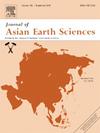A hybrid symbolic learning approach for Ground-Motion model Development
IF 2.7
3区 地球科学
Q2 GEOSCIENCES, MULTIDISCIPLINARY
引用次数: 0
Abstract
In earthquake engineering, ground-motion models (GMMs) constitute a research hotspot. They can be utilized for earthquake risk assessment, earthquake zoning maps, and seismic structural design. This paper put forward a hybrid symbolic learning (HSL) method, which combines the symbolic regression (SR) method (Chen et al, 2023) and random effect regression (RER), to construct a robust GMM for predicting peak ground acceleration (PGA), peak ground velocity (PGV), and pseudo-spectral acceleration (PSA) with different periods (0.01 s-4 s). To evaluate the effectiveness of HSL, we compared its predictive capacity and variability with those of the empirical regression models (ERM) and the SR model. The results demonstrate that HSL accurately captures magnitude and distance saturation, anelastic attenuation, and linear site amplification. It also produces comparable results to the ERM and SR models. Calculation of between- and within-event residuals and their standard deviations indicates that the HSL can obtain lower standard deviations than the SR model. As a new version of the symbolic learning method, HSL not only inherits the advantages of concise and interpretable equations as well as flexible parameter expansion of the model that SR possessed. In comparison with SR, HSL achieves lower standard deviations. Furthermore, HSL incorporates random effects regression, which upgrades SR to a partially non-ergodic GMM, i.e. considering the influence of ground motion characteristics on the results beyond the fixed effects component.

求助全文
约1分钟内获得全文
求助全文
来源期刊

Journal of Asian Earth Sciences
地学-地球科学综合
CiteScore
5.90
自引率
10.00%
发文量
324
审稿时长
71 days
期刊介绍:
Journal of Asian Earth Sciences has an open access mirror journal Journal of Asian Earth Sciences: X, sharing the same aims and scope, editorial team, submission system and rigorous peer review.
The Journal of Asian Earth Sciences is an international interdisciplinary journal devoted to all aspects of research related to the solid Earth Sciences of Asia. The Journal publishes high quality, peer-reviewed scientific papers on the regional geology, tectonics, geochemistry and geophysics of Asia. It will be devoted primarily to research papers but short communications relating to new developments of broad interest, reviews and book reviews will also be included. Papers must have international appeal and should present work of more than local significance.
The scope includes deep processes of the Asian continent and its adjacent oceans; seismology and earthquakes; orogeny, magmatism, metamorphism and volcanism; growth, deformation and destruction of the Asian crust; crust-mantle interaction; evolution of life (early life, biostratigraphy, biogeography and mass-extinction); fluids, fluxes and reservoirs of mineral and energy resources; surface processes (weathering, erosion, transport and deposition of sediments) and resulting geomorphology; and the response of the Earth to global climate change as viewed within the Asian continent and surrounding oceans.
 求助内容:
求助内容: 应助结果提醒方式:
应助结果提醒方式:


